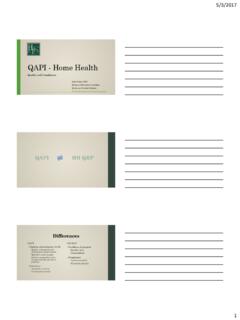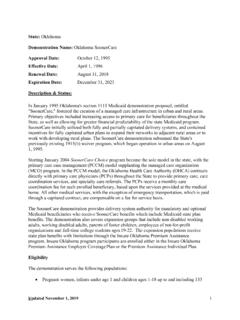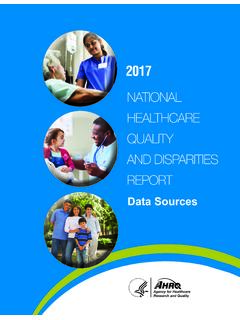Transcription of Summary of the CY 2022 Medicare Physician Fee Schedule ...
1 Summary of the CY 2022 Medicare Physician Fee Schedule final rule On November 2, 2021, the Centers for Medicare & Medicaid Services (CMS) released the calendar year (CY) 2022 Medicare Physician Fee Schedule (MPFS) final rule. This regulation also impacts the Quality Payment Program (QPP). CMS also released an accompanying fact sheet. The AAFP will thoroughly review the final rul e, which is effective on January 1, 2022, except where specified otherwise in the final rule. 2022 Medicare Conversion Factor and Estimated Impact on Family Medicine The conversion factor for 2022 is $ This lower than the 2021 conversion factor of $ This reduction can be primarily attributed to the expiration of a percent increase in the 2021 conversion factor, which Congress applied via legislation in December 2020.
2 The specialty impact estimates published by CMS do not account for the expiration of the percent increase in the 2021 conversion factor and therefore do not reflect the expected impact on family medicine. Clinical Labor Pricing Update For the first time since 2002, CMS will update the clinical labor portion of practice expense relative value units (RVUs) to reflect current wage data and other clinical labor costs. The update will occur over a four-year transition period. Telehealth Changes CMS will retain all services previously added to the Medicare telehealth services list on a Category 3 (temporary) basis until the end of calendar year 2023. Relevant services for family physicians include: Domiciliary, Rest home , or Custodial care services, Established patients (Current Procedural Terminology (CPT) 99336-99337)) home Visits, Established Patient (CPT 99349-99350) Emergency Department Visits, Levels 1-5 (CPT 99281-99285) Nursing facility discharge day management (CPT 99315-99316) Hospital discharge day management (CPT 99238-99239) Subsequent Observation and Observation Discharge Day Management (CPT 99217.
3 99224-99226) To implement the telehealth provisions in the Consolidated Appropriations Act of 2021, CMS will do the following, effective after the end of the COVID-19 public health emergency (PHE): Remove geographic restrictions for telehealth services provided to diagnose, evaluate, or treat a mental health disorder Add home of the patient as a permissible originating site for telehealth services for the diagnosis, evaluation, or treatment of a mental health disorder Require, as a condition of payment for mental health telehealth services, that the billing practitioner (or another practitioner of the same subspecialty in the same group) must have furnished an in-person service to the beneficiary within the 6-month period before the date of the initial telehealth service and at least every 12 months thereafter.
4 Exceptions to the in-person visit requirement may be made based on beneficiary circumstances (with the reason 2 documented in the patient s medical record), and more frequent visits are allowed, as driven by clinical needs on a case-by-case basis. Also, CMS will cover audio-only telehealth services for the diagnosis, evaluation, or treatment of a mental health disorder when the following conditions are met: The originating site of the visit is the patient s home , The furnishing practitioner has the capacity to furnish the service using interactive two-way,real-time audio/video technology but instead used audio-only in an instance where thebeneficiary is unable to use, does not wish to use, or does not have access to two-wayaudio/video technology, and An in-person service must be furnished within 6 months of the initial audio-only also finalized a requirement for the use of a new modifier for services furnished using audio-only communications.
5 CMS will permanently adopt coding and payment for HCPCS code G2252 (Brief communication technology-based service, , virtual check-in, by a Physician or other qualified health care professional who can report evaluation and management services, provided to an established patient, not originating from a related E/M service provided within the previous 7 days nor leading to an E/M service or procedure within the next 24 hours or soonest available appointment; 11 20 minutes of medical discussion). Valuation of Specific Codes CMS has valued multiple CPT and Healthcare Common Procedure Coding System (HCPCS) codes that are new or revised for 2022. Of most interest to family physicians will be CMS s valuation of codes for chronic care management (CCM) and principal care management (PCM).
6 CMS accepted the work relative value units (RVUs) and direct practice expense inputs recommended by the Relative Value Scale Update Committee for all these codes, which will mean an increase in the work RVUs for each of the existing CCM codes and one of the two PCM codes, which will be converting from HCPCS codes to CPT codes. Evaluation and Management (E/M) Visits CMS is implementing policy changes in three areas. One relates to split (or shared) visits by a Physician and a non- Physician provider (NPP) who are in the same group. In the final rule, CMS establishes the following: Definition of split (or shared) E/M visits as E/M visits provided in the facility setting by aphysician and an NPP in the same group.
7 The visit is billed by the Physician or NPP whoprovides the substantive portion of the visit. For 2022, the substantive portion can be history, physical exam, medical decision-making, ormore than half of the total time (except for critical care , which can only be more than half of thetotal time). In 2023, CMS will define the substantive portion of the visit as more than half of thetotal time spent. Split (or shared) visits can be reported for new as well as established patients, initial andsubsequent visits, and prolonged services. CMS requires a modifier on the claim to identify these Documentation in the medical record must identify the two individuals who performed the individual providing the substantive portion must sign and date the medical area concerns payment for teaching physicians services.
8 CMS finalized and clarified that when time is used to select the office/outpatient E/M visit level, only the time spent by the teaching Physician in qualifying activities, including time that the teaching Physician was present with the resident performing those activities, can be included for purposes of visit level selection. Under the primary care exception, time cannot be used to select visit level; only medical decision-making may be used to select the E/M visit level. Rural health Clinics (RHCs) and Federally Qualified health Centers (FQHCs) CMS finalized its proposal to allow RHCs and FQHCs to bill for transitional care management and other care management services furnished for the same beneficiary during the same service period, provided all requirements for billing each code are met.
9 CMS also finalized its proposal to revise the current regulatory language for RHC or FQHC mental health visits to include visits furnished using interactive, real-time telecommunications technology. This change will allow RHCs and FQHCs to report and receive payment for mental health visits furnished via real-time telecommunication technology in the same way they currently do when visits take place in-person, including audio-only visits when the beneficiary is not capable of, or does not consent to, the use of video technology. CMS finalized that an in-person, non-telehealth visit must be furnished at least every 12 months for these services, although exceptions to the in-person visit requirement may be made based on beneficiary circumstances (with the reason documented in the patient s medical record) and more frequent visits are allowed, as driven by clinical needs on a case-by-case basis.
10 Vaccine Administration Services Effective January 1, 2022, CMS will pay $30 per dose for the administration of the influenza, pneumococcal and hepatitis B virus vaccines. In addition, CMS will maintain the current payment rate of $40 per dose for the administration of the COVID-19 vaccines through the end of the calendar year in which the ongoing PHE ends. Effective January 1 of the year following the year in which the PHE ends, the payment rate for COVID-19 vaccine administration will be set at a rate to align with the payment rate for the administration of other Part B preventive vaccines. CMS will continue the additional payment of $ for COVID-19 vaccine administration in the home under certain circumstances through the end of the calendar year in which the PHE ends.












